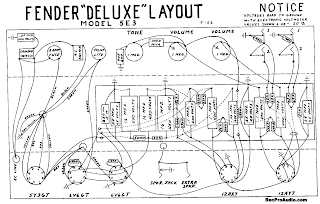The Fender Tweed Deluxe has been with us for over 60 years now and it's popularity is still growing. First produced in 1948 as the Model 5B3 it is the mid 50s 5E3 circuit that guitar player claim is the greatest revision of the classic Tweed formula.
Originally viewed as an "entry level" model the Tweed Deluxe has become one of the most recorded and iconic guitar amps of all time. It's sweet breakup and touch sensitive nature really allow the guitarist to feel like they are truly in control of the circuitry with every tone required available from slight alterations in pick attack or the guitar volume control.
If, somehow, you've never heard a Fender Tweed in action here's a demo video;
And another of a clone in action;
So, let's have a look at the schematic;
Super simple for a push-pull amp. All there is is two cascaded preamp stages a super simple "Cathodyne" phase inverter and a cathode biased push-pull power stage. The power supply is pretty poorly regulated and combined with the valve rectification isn't exactly what amp designers would call "Stiff". It's this simplicity combined with an errant luck of design that make the 5E3 the legendary amp it is. Below is the original layout as used in the actual amps themselves;
For a full project pdf file with schematics and layout files (and a few mods!) check this out;
Here's a great site with loads of discussion on Tweed builds/mods and tones. There's some great demos too; http://www.recproaudio.com/diy_pro_audio/tweed_deluxe.htm


.gif)


What do you think about the ceriatone layout? Do you think it is close enough to the original? I mean, would it be a tonal diference?
ReplyDeleteBy the way, thank you so much and congrats for the blog
ReplyDeleteThis article gives the light in which we can observe the reality. This is very nice one and gives indepth information. Thanks for this nice article. Reverb Time Calculator
ReplyDeletevery useful and lovely post which is full of knowledge please keep posting such useful posts.
ReplyDeletecanonprinter